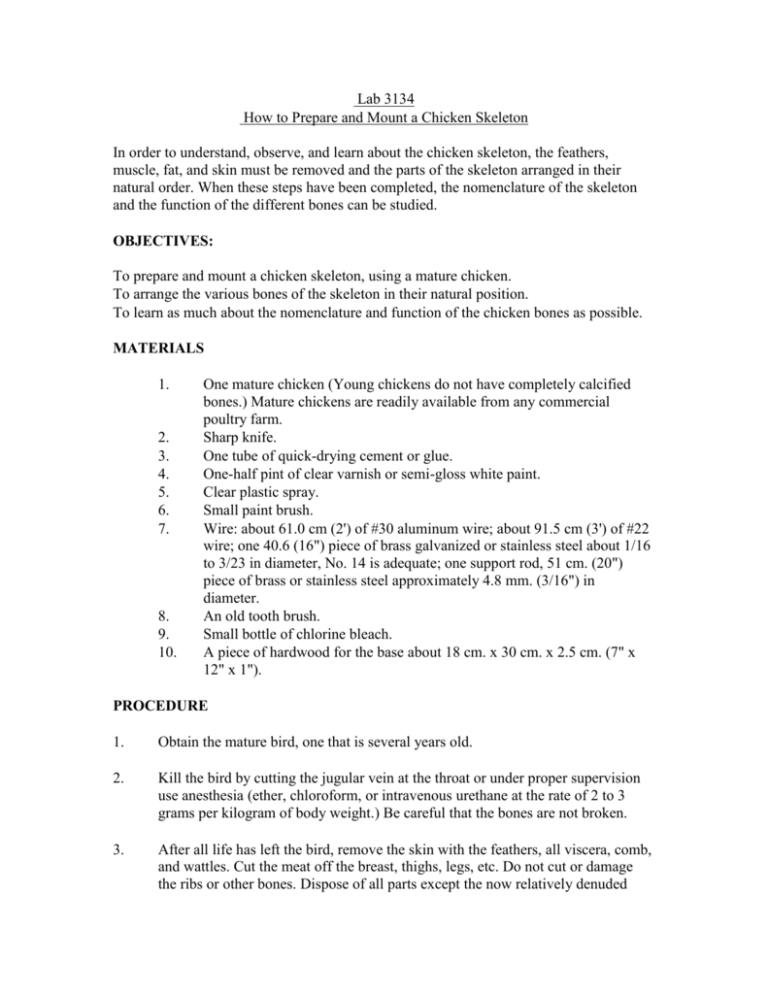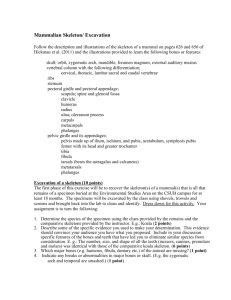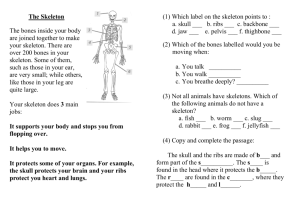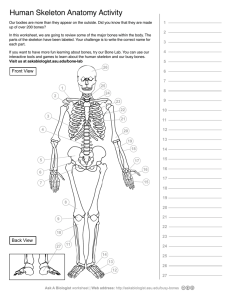How to Prepare and Mount a Chicken Skeleton
advertisement

Lab 3134 How to Prepare and Mount a Chicken Skeleton In order to understand, observe, and learn about the chicken skeleton, the feathers, muscle, fat, and skin must be removed and the parts of the skeleton arranged in their natural order. When these steps have been completed, the nomenclature of the skeleton and the function of the different bones can be studied. OBJECTIVES: To prepare and mount a chicken skeleton, using a mature chicken. To arrange the various bones of the skeleton in their natural position. To learn as much about the nomenclature and function of the chicken bones as possible. MATERIALS 1. 2. 3. 4. 5. 6. 7. 8. 9. 10. One mature chicken (Young chickens do not have completely calcified bones.) Mature chickens are readily available from any commercial poultry farm. Sharp knife. One tube of quick-drying cement or glue. One-half pint of clear varnish or semi-gloss white paint. Clear plastic spray. Small paint brush. Wire: about 61.0 cm (2') of #30 aluminum wire; about 91.5 cm (3') of #22 wire; one 40.6 (16") piece of brass galvanized or stainless steel about 1/16 to 3/23 in diameter, No. 14 is adequate; one support rod, 51 cm. (20") piece of brass or stainless steel approximately 4.8 mm. (3/16") in diameter. An old tooth brush. Small bottle of chlorine bleach. A piece of hardwood for the base about 18 cm. x 30 cm. x 2.5 cm. (7" x 12" x 1"). PROCEDURE 1. Obtain the mature bird, one that is several years old. 2. Kill the bird by cutting the jugular vein at the throat or under proper supervision use anesthesia (ether, chloroform, or intravenous urethane at the rate of 2 to 3 grams per kilogram of body weight.) Be careful that the bones are not broken. 3. After all life has left the bird, remove the skin with the feathers, all viscera, comb, and wattles. Cut the meat off the breast, thighs, legs, etc. Do not cut or damage the ribs or other bones. Dispose of all parts except the now relatively denuded carcass. Caution: Care should be taken to prevent cutting poorly calcified portions of the skeleton. Special care must be taken when cutting in the region of the head, face, and digits. 4. Remove the scales from the tarsometatarsus and digits of the feet. 5. Remove the viscera and be careful not to break the pubic bones. It is not essential to remove all soft tissue from the skeleton. 6. Fold the leg wings and neck along the body and tie with a string to make a small compact mass of intact skeleton. 7. Put the carcass in a container and cover it with water. Boil the water for at least two hours, reduce the heat and allow the carcass to simmer for another 4 hours. Using a pressure cooker will shorten the cooking time. Cool the cooked carcass and strip off any remaining flesh. Then scrub the bones clean with a toothbrush. Stringing the bones of the neck and tail with wire will keep them in order and make the assembly job easier. 8. After the skeleton has dried at room temperature or baked at 93° C. (200°F.) for an hour the bones can be bleached by placing them in a solution of 3% hydrogen peroxide or in a solution of 0.25 liter (1 cup) of chlorine bleach in 3.8 liters (4 quarts) of water for 24 hours. 9. After drying the skeleton for several days, it is ready to be mounted. 10. Mounting the skeleton: The piece of hardwood and stiff metal rod will be needed to support the skeleton. a. b. Split one end of the rod with a fine end metal saw and bend the two resultant prongs into shape of a U or saddle. Now bend the rod so that the saddle will fit around the thoracic vertebra between the ribs no. 2 and 3. Carefully bend the rod (do not bend while it is attached to the skeleton) until it will pass in the mid saffital plane, from just below the thoracic vertebra diagonally down to the caudal tip of the metasternum, then continue the rod ventrally at a slope of approximately 135°. The lower end of the rod will eventually be fixed in the center of the wood base. Until this is done, the rod can be held in a vise. Push a piece of heavy wire as far as possible inside the neural canal of the fused vertebra of the back, then bend it in a S shape curve to resemble the natural curve of the neck of the bird. Put the first thoracic vertebra in place, and then put the cervical vertebra on the wire and push them into their normal positions with the zygophyses overlapping. After the cervical vertebra is in place, cut the wire so that it will support the skull in a natural position. All c. d. e. f. g. h. cervical vertebras can be glued. Use a quick drying airplane glue for this. The femurs of the legs must be inserted into the acetabula of the pelvic girdle. Hold them in place with a pin of medium size wire extending from one femur through the acetabula cavities to the second femur. Make the holes for this pin with a small drill. The bones of the legs can be wired together or glued with quickdrying cement. In some cases the bones may be held in a normal position by the ligaments. After attaching the legs to the pelvic girdle as described above, you can determine the length of the support rod. Cut the rod the necessary length to support the skeleton in an upright position and anchor it to the 18 cm. x 30 cm. x 2.5 cm. (7" x 12" x 1") support piece of hardwood. The phalanges of the digits can now be straightened and put into normal position. Use small drops of quick-drying cement to hold the digits against the wood base. The bones of the wing can be wired or cemented into position. Usually the humerus and the radius and the ulna are parallel to the scapula and carpometacarpus and digits extends ventrally at a 90° angle from the forearm. For additional support use a piece of medium size wire to thread the wing bones and the vertebra together. The lower jaw (mandible) can be cemented or wired at the point of contact with quadrate. The hyoid apparatus which supports the tongue can be put in place and cemented or supported by cemented thread. If the strain is not great, the thread works well and is hardly noticeable. The ocular rings may be suspended in two places by cemented thread. When the skeleton is in its final position, you can retouch many joints with quick-drying cement. Then spray it with clear plastic for preservation or brush it with a thin coat of varnish. REPORTING RESULTS In reporting your skeleton, be sure to include a detailed account of the time and materials needed to accomplish this project. 1. THE NORMAL CHICKEN. a. The normal heart beats per minute for an adult chicken is 250-300. i. The normal heart beats per minute for a baby chick is 350-450. ii. For comparison, the human average is 70 and the pig is 58 to 86 beats per minute. iii. The normal respiration rates or breaths per minute is 12-20 for a male chicken and 20-36 for a female chicken. iv. For comparison, the human is 12. Usually the very tiny and the very large animals have a high rate as the elephant and the shrew both have 96. v. The body temperature of a chicken averages 106.5 degrees. vi. The heartbeat can be taken either by a stethoscope or by gently pushing against an artery in the leg and counting the beats. vii. For comparison, the body temperature of a human is 98.6 and of a dog, 101.5 - 102 degrees. viii. The body temperature can be taken by using a rectal thermometer. b. Checking the legs, comb and feet. i. Is the comb a healthy color? Is it a good red or are there patches of white indicating disease? ii. Are there lesions on the comb? Is the face puffy? iii. How do the legs look? Are they fairly smooth or are there scales on them? Is the chicken lame or does it walk normally? iv. The feet should not be swollen or have any lesions on them. The toes should be straight. v. The reason the skin, comb, beak and feet are examined is because many diseases can be detected through examination. (1) Blucomb affected chickens have dark and dried combs and wattles. This darkening starts at the outer edge and progresses toward the base. (2) Fowl cholera causes the wattle to swell and fill with a cheesy pus. (3) The common virus cause Fowl Pox, which is the skin form, produces brownish scabs on the comb, face and wattles. They are wart like and won't peel off. (4) With Leukosis disease, the leg bone enlarges noticeably. (5) When a chicken has infectious Coryza, the tissue swells around the eyes until the eyes are nearly closed. (6) A chick deficient in Vitamin D, shows ungainly manner of balancing body and the beak is soft and rubbery. (7) With Biotin deficiency, there are severe lesions on the bottom of the feet.






